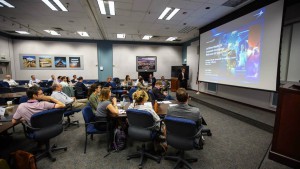8th September 2015 Los Angeles, USA
2015: A Space Blogyssey Part 2
with contributions by Stefania Di Mauro-Nava
*This is part 2 of a multi-part blog series on the UK space sector*
Led by Innovate UK, with support from UK Trade and Investment (UKTI) and the UK Science and Innovation Network (UK SIN), nine representatives from UK-based start-ups in the space and nanosatellite applications sector got the opportunity to visit Utah and California as part of the Space and Satellite Applications Entrepreneurs Mission, where they interacted with world leading investors and companies.
The mission started off in Utah at the AIAA/USU Conference on Small Satellites and a meeting with NASA’s Jet Propulsion Laboratory. The mission then headed to California. UK Science and Innovation Officers, Stefania and Patricia, accompanied the mission and highlight their thoughts below.
—
Starting in San Francisco…
In a true display of Californian hospitality, the Space and Satellite Applications Entrepreneurs Mission delegates were greeted by a warm and sunny day in Palo Alto, where their first stop was meeting with representatives of the Advanced Technology Centre (ATC) at Lockheed Martin, a global industry leader in aerospace, defence, security and advanced technologies.

Courtesy of Innovate UK
Lockheed emphasised their commitment to working with small and medium sized enterprises on a number of projects. It was exciting to note that outside of the US, the UK has one of the largest numbers of Lockheed employees at around 3,300 and run a number of programmes to help facilitate interactions with academia and start-ups. This includes the Virtual Technology Cluster and the LM Harwell Space Technology Centre.
The mission then travelled north to San Francisco where they met with representatives from three venture capital (VC) firms hosted by O’Reilly Alpha Tech Ventures (OATV).
Each of the delegates were given the opportunity to give a 3 minute pitch about their company and what they were looking for from investors. The VC representatives spent time with the group discussing what VC firms in the area typically looked for when investing – the need for a “wow factor” and emotional response. In other words, how will your start-up revolutionize the industry? With those parting words, the group headed to the airport for their third and final leg of their trip.
Moving on to Los Angeles…
The group then attended a University of Southern California (USC) Space Tech briefing. Hosted by the USC Space Engineering Research Centre Director, Professor David Barnhart, this event was a chance for US and UK companies to express their views on the state of the small satellite industry. The entrepreneurs agreed that governmental regulations result in barriers to the democratisation of space.
The companies discussed how open source data could decrease profit but increase proliferation of small satellites. Therein lies the quandary of their situation; with open source data comes the ability to build things faster, but also the undesired effect of losing money. I found the discussion of the current business model reminiscent of how iPhones are manufactured. Companies don’t manufacture long-lasting products; rather, they make a less durable version that lasts two years in order to drive profits and repeat customers. This inevitably led to a discussion about space debris.
Talk of a space “vacuum” to remove debris had me visualising the Pixar movie Wall-E, a sole trash collector in the dark abyss. The companies debated the future of small satellites and how one day everyone on Earth could have a personal satellite. I contemplated how I would use a personal satellite. Wouldn’t a drone be more convenient? I wasn’t the only one asking this question. David asked the question: Are drones complementary or competitive for satellites? Both, the group agreed. Drones are in the same market as personal satellites but for now, the sectors stay away from each other. My guess is that the persistence of satellites versus drones keeps them from competing.
The afternoon ended with a pitch session to the Space Angels Network. Tom from Alba Orbital Ltd made me wonder why his technology hadn’t been thought of before. Tom’s company makes small satellites that would have a communication link to airplanes so that something like Malaysia Airlines would never happen again. Mike Lawton from Oxford Space Systems did a pitch with props and we are happy to learn that Oxford Space Systems secured £1.2 million in its second round of fundraising just prior to the mission!
The last stop of the week was Virgin Galactic, which was hosted by CEO George Whitesides, who discussed how excited they were about not only putting people in space, but also satellites. He has a vision for Virgin to be the “Uber” of small satellite launchers. LauncherOne (L1) will go exactly where you want, at the orbit that you’re looking for, and at the time that you choose. He hopes to have L1 operational in 2017.
Virgin had some pretty lofty aspirations; opening up space for the entire world is only worthwhile if everyone wants to go to space. For me though, there are too many things to think about on the ground that keep my head out of the clouds.
—
For more information about the mission, participating companies and programme, please visit the Space and Satellite Applications Entrepreneurs Mission website.
Please stay tuned for the third blog in this series which will come after the SpaceCom Expo in November. The Satellite Applications Catapult is a key sponsor of SpaceCom Expo and the CEO Stuart Martin will be leading several discussion panels about the international commercialization of space.